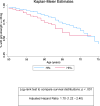Effect of HIV-infection and cumulative viral load on age-related decline in grip strength
- PMID: 27603294
- PMCID: PMC5083134
- DOI: 10.1097/QAD.0000000000001245
Effect of HIV-infection and cumulative viral load on age-related decline in grip strength
Abstract
Objective: Grip strength predicts functional decline and death, and is regarded as a biomarker of biological aging. The primary objective of this manuscript was to assess differences in the rate of decline in grip strength in persons aging with and without HIV.
Design: Grip strength was assessed in 1552 (716 HIV+ and 836 HIV-) men aged at least 50 years participating in the Multicenter AIDS Cohort Study between 2007 and 2014.
Methods: Grip strength decline was modeled longitudinally, adjusting for serostatus, demographics, comorbidities, and conditions. In HIV-specific models, coefficients were included for cumulative viral load and history of AIDS.
Results: Grip strength at the age of 50 years averaged 37.9 and 38.2 kg for HIV+ and HIV- men, respectively (P = 0.70). In fully adjusted models, grip strength declined 0.33 kg/year in HIV- men (P < 0.001) and 0.42 kg/year in HIV+ men (P = 0.01). In HIV-stratified models, higher cumulative viral load indicated greater strength decline (-0.884 kg for 3.1-4.0 log10 copies-years/ml and -1.077 kg for ≥4.1 log10 copies-years/ml) relative to men with consistently low viral load (≤3.0 log10 copies-years/ml). Adjusted Cox proportional hazard models revealed a 70% greater risk of clinically weak grip strength in HIV+ men (adjusted hazard ratio 1.70; 95% confidence interval, 1.22-2.40).
Conclusion: Grip strength decline is accelerated in HIV-infected men, which may contribute to decreased life expectancy and lower quality of life with aging. Greater cumulative viral load exposure appears to be an important driver of this decline and underscores the importance of early initiation of therapy.
Conflict of interest statement
None of the authors has an association that may pose a conflict of interest for the present work.
Figures


References
-
- Centers for Disease Control and Prevention. HIV Surveillance Report, 2014. 2015:26.
-
- Bruunsgaard H, Pedersen BK. Age-related inflammatory cytokines and disease. Immunology and allergy clinics of North America. 2003;23(1):15–39. - PubMed
Publication types
MeSH terms
Grants and funding
- U01 AI035042/AI/NIAID NIH HHS/United States
- K23 AG050260/AG/NIA NIH HHS/United States
- K24 AI120834/AI/NIAID NIH HHS/United States
- U01 AI035041/AI/NIAID NIH HHS/United States
- UM1 AI035043/AI/NIAID NIH HHS/United States
- U01 AI035040/AI/NIAID NIH HHS/United States
- U01 AI035039/AI/NIAID NIH HHS/United States
- K01 AG048765/AG/NIA NIH HHS/United States
- UL1 TR001079/TR/NCATS NIH HHS/United States
- P30 AI094189/AI/NIAID NIH HHS/United States
- UL1 TR000424/TR/NCATS NIH HHS/United States
- R01 AI093520/AI/NIAID NIH HHS/United States
- K01 AI093197/AI/NIAID NIH HHS/United States
- U01 AI069918/AI/NIAID NIH HHS/United States
LinkOut - more resources
Full Text Sources
Other Literature Sources
Medical

